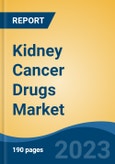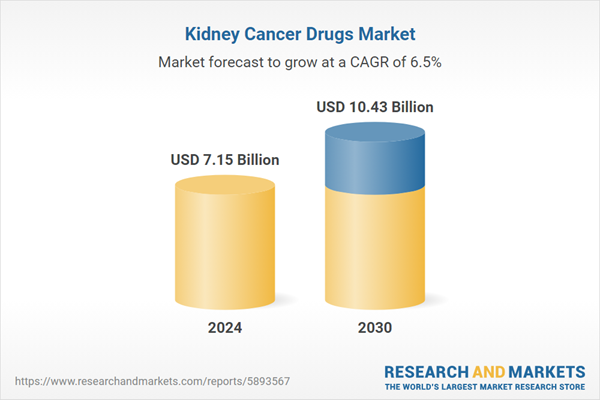Free Webex Call
The Kidney Cancer Drugs Market was valued at USD 7.15 Billion in 2024, and is expected to reach USD 10.43 Billion by 2030, rising at a CAGR of 6.45%. Kidney cancer, also known as renal cell carcinoma, is a type of cancer that originates in the kidneys, the bean-shaped organs responsible for filtering waste and excess fluids from the blood to form urine. Kidney cancer, medically termed renal cell carcinoma (RCC), is a complex and challenging disease that demands effective treatment strategies. As medical research advances and pharmaceutical innovation accelerates, several key drivers are propelling the growth and evolution of the kidney cancer drugs market. Speak directly to the analyst to clarify any post sales queries you may have.
10% Free customizationThis report comes with 10% free customization, enabling you to add data that meets your specific business needs.
Targeted therapies are a class of drugs designed to inhibit specific molecules or pathways that are crucial for cancer cell growth and survival. In kidney cancer, targeted therapies have revolutionized treatment. Examples include tyrosine kinase inhibitors (TKIs) such as sunitinib, pazopanib, and axitinib. These drugs disrupt the signaling pathways that promote tumor growth and angiogenesis (formation of new blood vessels).
The landscape of kidney cancer treatment has been dramatically transformed by the introduction of these drugs. Patients who once faced limited options now have access to a range of therapies that offer improved survival rates and enhanced quality of life. As research continues, the kidney cancer drugs market is poised for further advancements. Combination therapies, personalized medicine approaches, and the integration of novel targets are on the horizon. Additionally, the ongoing collaboration among researchers, pharmaceutical companies, healthcare organizations, and patient advocacy groups will continue to shape the development of innovative therapies and ultimately lead to better outcomes for patients facing kidney cancer.
Key Market Drivers
Rising Incidence of Kidney Cancer
The global kidney cancer market is experiencing significant expansion, largely driven by the rising incidence of kidney cancer worldwide. In 2022, kidney cancer accounted for 434,840 newly diagnosed cases globally, making it the 14th most prevalent cancer worldwide. It ranked as the 10th most diagnosed cancer among men and the 13th among women, underscoring its significant impact on global healthcare systems and oncology markets. The increasing number of renal cell carcinoma (RCC) cases - the most common type of kidney cancer - has created a growing demand for advanced diagnostics, innovative therapeutics, and improved healthcare infrastructure.This trend is not only shaping market dynamics but also influencing the strategic direction of pharmaceutical companies, healthcare providers, and investors. The global population is aging at an unprecedented rate. Between 1974 and 2024, the proportion of individuals aged 65 and older nearly doubled, rising from 5.5% to 10.3%, and age is a significant risk factor for kidney cancer. With higher life expectancy, the number of kidney cancer cases is expected to increase, driving demand for effective treatment options. Developed regions such as North America and Europe report higher incidence rates due to advanced screening programs and improved diagnostic capabilities. Meanwhile, emerging economies in Asia-Pacific are seeing rising cases due to lifestyle changes and increasing industrialization, leading to a higher demand for cancer therapeutics.
Key Market Challenges
Resistance and Treatment Heterogeneity
Despite the advancements in targeted therapies and immunotherapies, the development of resistance to these treatments remains a significant challenge in kidney cancer. Over time, tumors can evolve and adapt, rendering once-effective therapies ineffective. This challenge underscores the need for continuous research to understand the mechanisms of resistance and develop strategies to overcome it. Additionally, kidney cancer is not a homogeneous disease. Different subtypes and genetic variations contribute to variations in treatment response. Developing therapies that are effective across diverse patient populations is a complex endeavor that requires a deep understanding of tumor biology and personalized medicine approaches.Key Market Trends
Personalized Medicine Revolution
The era of personalized medicine has dawned upon the field of kidney cancer treatment, offering immense promise for improved patient outcomes. With the advent of precision oncology, the one-size-fits-all approach to treatment is giving way to tailored interventions that account for individual genetic profiles and biomarker expression. Advancements in genomics and molecular diagnostics enable oncologists to identify specific genetic mutations or alterations driving a patient's kidney cancer. Armed with this information, they can prescribe targeted therapies that are more likely to elicit a favorable response. This shift towards personalized treatment approaches not only enhances the efficacy of drugs but also minimizes the potential for adverse effects.Key Market Players
- Novartis AG
- Pfizer Inc.
- Bayer AG
- Genentech Inc.
- Bristol-Myers Squibb
- Eisai Co., Ltd.
- Exelixis Inc
- Prometheus Laboratories Inc
- Glaxosmithkline PLC.
- F. Hoffmann-LA Roche AG
Report Scope:
In this report, the Global Kidney Cancer Drugs Market has been segmented into the following categories, in addition to the industry trends which have also been detailed below:Kidney Cancer Drugs Market, By Therapeutic Class:
- Targeted Therapy
- Immunotherapy
- Chemotherapy
Kidney Cancer Drugs Market, By Pharmacologic Class:
- Angiogenesis Inhibitors
- Monoclonal Antibodies
- mTOR Inhibitors
- Cytokine Immunotherapy (IL-2)
Kidney Cancer Drugs Market, By Region:
- North America
- United States
- Canada
- Mexico
- Asia-Pacific
- China
- India
- South Korea
- Australia
- Japan
- Europe
- Germany
- France
- United Kingdom
- Spain
- Italy
- South America
- Brazil
- Argentina
- Colombia
- Middle East & Africa
- South Africa
- Saudi Arabia
- UAE
Competitive Landscape
Company Profiles: Detailed analysis of the major companies present in the Global Kidney Cancer Drugs Market.Available Customizations:
With the given market data, the publisher offers customizations according to a company's specific needs. The following customization options are available for the report.Company Information
- Detailed analysis and profiling of additional market players (up to five).
This product will be delivered within 1-3 business days.
Table of Contents
1. Product Overview
2. Research Methodology
3. Executive Summary
5. Global Kidney Cancer Drugs Market Outlook
6. North America Kidney Cancer Drugs Market Outlook
7. Europe Kidney Cancer Drugs Market Outlook
8. Asia-Pacific Kidney Cancer Drugs Market Outlook
9. South America Kidney Cancer Drugs Market Outlook
10. Middle East and Africa Kidney Cancer Drugs Market Outlook
11. Market Dynamics
12. Market Trends & Developments
14. Porter’s Five Forces Analysis
15. Competitive Landscape
Companies Mentioned
- Novartis AG
- Pfizer Inc.
- Bayer AG
- Genentech Inc.
- Bristol-Myers Squibb
- Eisai Co., Ltd.
- Exelixis Inc
- Prometheus Laboratories Inc
- Glaxosmithkline PLC.
- F. Hoffmann-LA Roche AG
Table Information
| Report Attribute | Details |
|---|---|
| No. of Pages | 185 |
| Published | March 2025 |
| Forecast Period | 2024 - 2030 |
| Estimated Market Value ( USD | $ 7.15 Billion |
| Forecasted Market Value ( USD | $ 10.43 Billion |
| Compound Annual Growth Rate | 6.4% |
| Regions Covered | Global |
| No. of Companies Mentioned | 10 |









